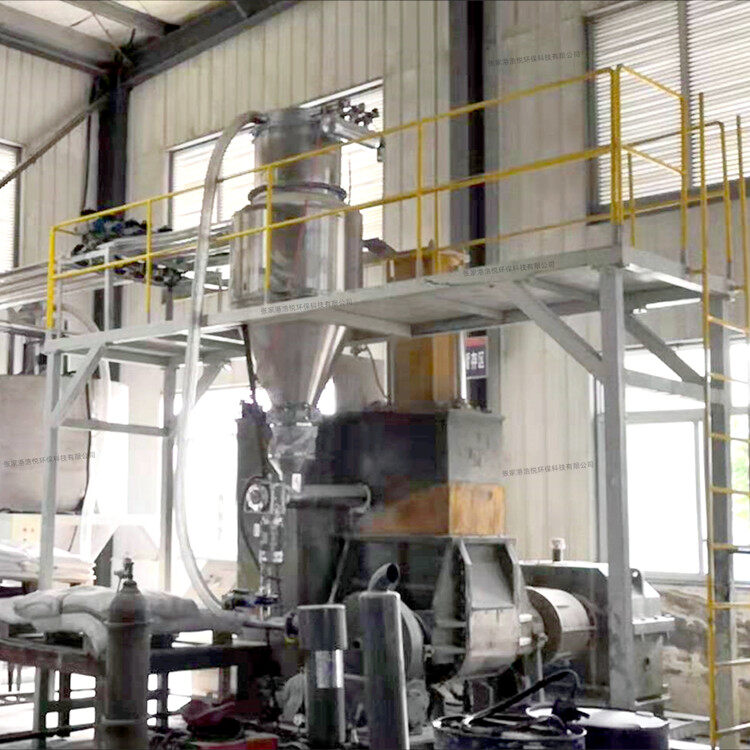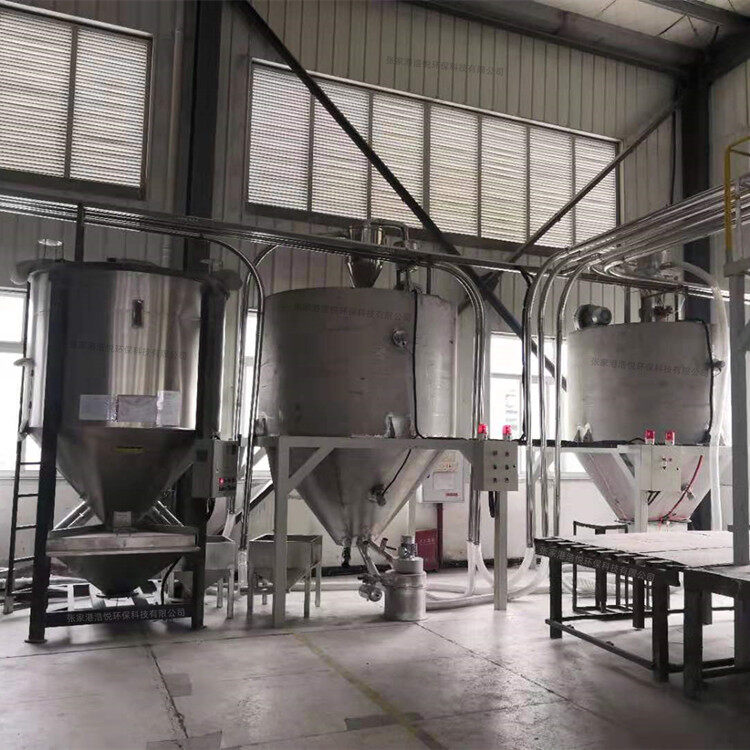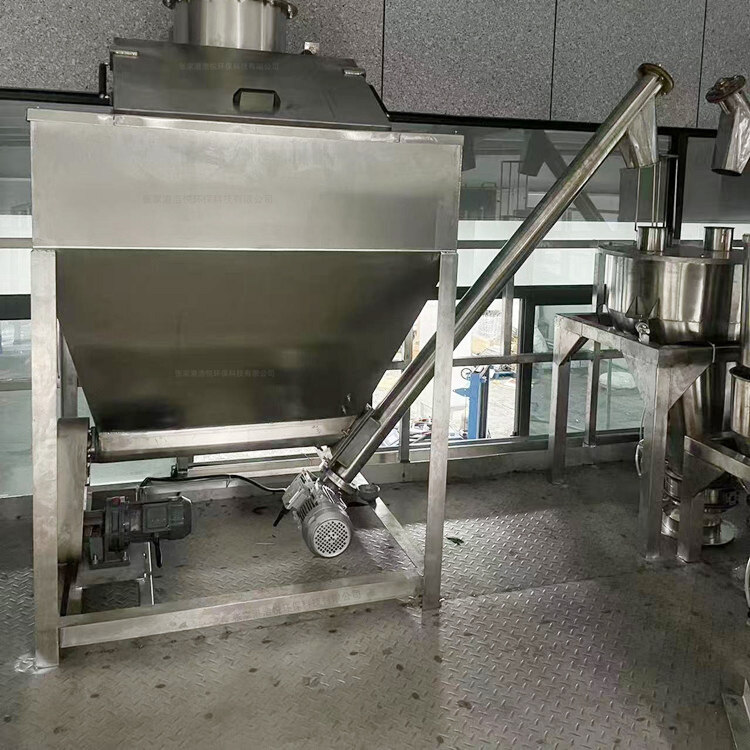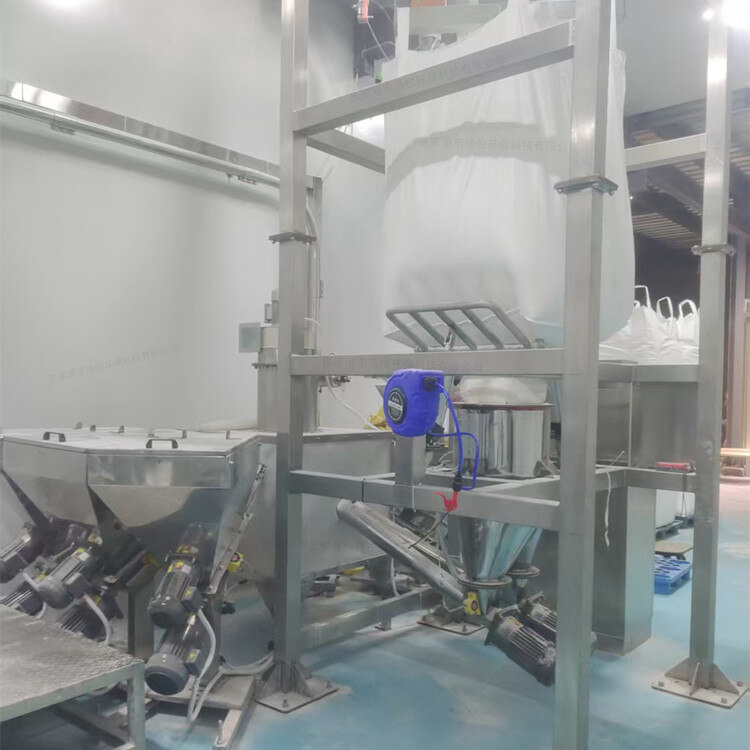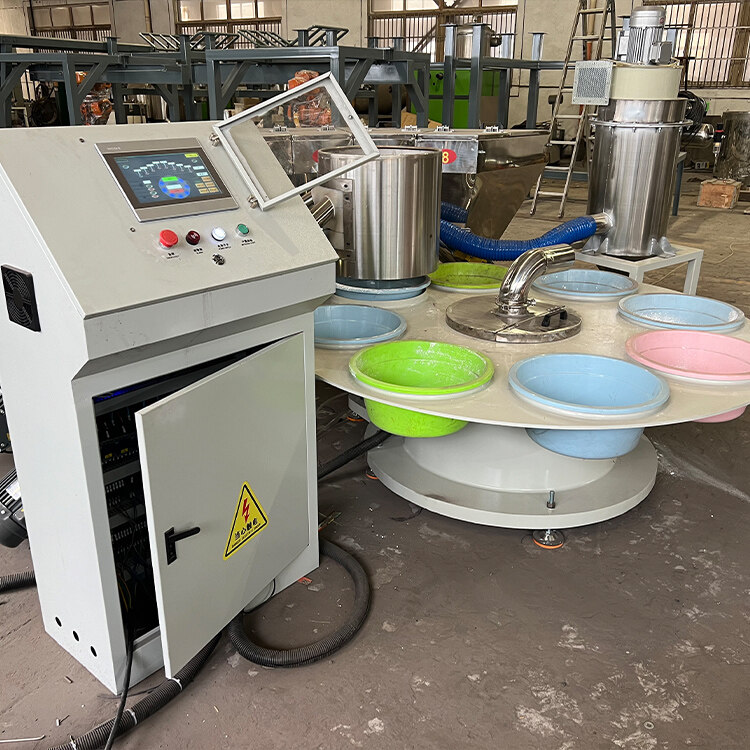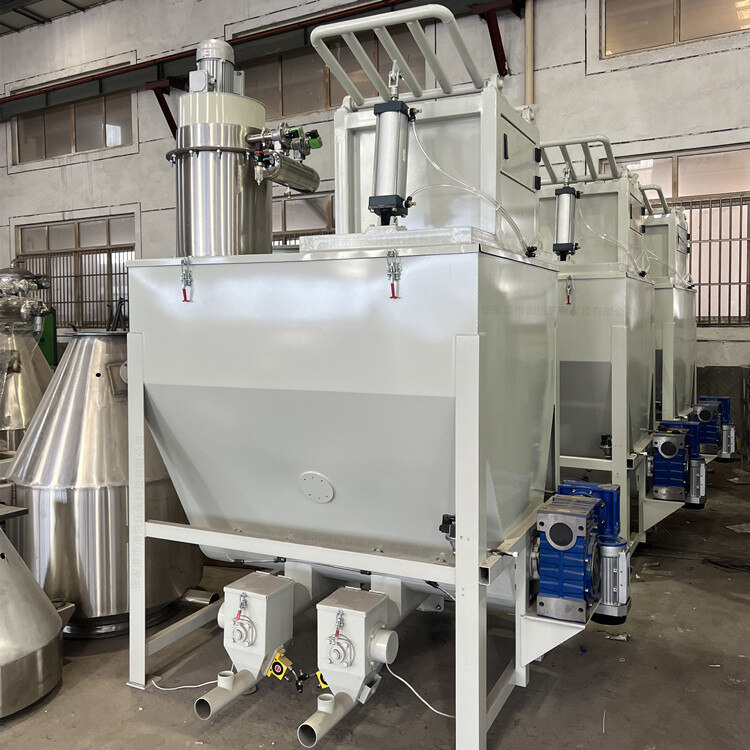- Introduction to automatic batching machine and fully automatic batching machine equipment
- The powder metering system tells you about the introduction of the mixing and drying machine
- 1000kg vacuum feeding machine
- Fully automatic small material batching system
- Research on Innovation of Automatic Weighing Machine Technology
- Design and operation of automatic batching system using PLC, industrial computer and frequency converter
Negative pressure feeding system
- Category:Automatic metering and conveying equipment
- Hits:252次
- Release Date:2025-06-30
- Share:
- Inquiry
- Details
In the trend of pursuing high efficiency, environmental protection, and automation in industrial production, negative pressure feeding system, as an advanced material transportation solution, achieves dust-free and precise transportation of powdered and granular materials by utilizing the principle of vacuum negative pressure. It is widely used in multiple industries such as food, pharmaceuticals, chemicals, and new energy. The following will provide a comprehensive and in-depth introduction to the negative pressure feeding system from the aspects of system composition, working principle, core advantages, application scenarios, and development trends.
1、 System core composition architecture
The negative pressure feeding system mainly consists of six modules: vacuum generating device, feeding unit, conveying pipeline, separation and unloading device, dust removal system, and control system. Each part is closely coordinated to form a complete automated feeding system.
(1) Vacuum generating device
The vacuum generating device is the power core of the negative pressure feeding system, usually using vacuum pumps (such as Roots vacuum pumps, rotary vane vacuum pumps) or negative pressure fans. Roots vacuum pump is suitable for material conveying scenarios with high flow rates and long distances (up to 100 meters or more), and can generate high vacuum levels (-30kPa to -80kPa); Negative pressure fans are commonly used for short distance (generally ≤ 30 meters) and low flow conveying, with the characteristics of low cost and simple maintenance. In flammable and explosive special environments, water ring vacuum pumps are used, which form a vacuum through water as a medium, effectively avoiding safety hazards caused by static electricity.
(2) Loading unit
The feeding unit is responsible for introducing materials into the system, and common forms include manual feeding hoppers and automatic feeding devices. The design of the manual feeding hopper conforms to ergonomics, making it convenient for operators to pour small bags of materials. Some feeding hoppers are also equipped with dust removal filters, which can absorb the dust generated during the feeding process and prevent dust pollution. The automatic feeding device is connected to the storage bin and evenly and stably feeds the materials into the conveying pipeline through equipment such as star shaped unloaders and spiral feeders. These feeding devices can accurately control the supply speed and flow rate of materials according to the instructions of the control system.
(3) Transportation pipeline
The conveying pipeline is a channel for material transportation, generally made of stainless steel, carbon steel, or food grade engineering plastic materials, selected according to the characteristics of the material (such as corrosiveness and abrasion). The inner diameter of the pipeline is determined based on the material flow rate and conveying speed, usually between 50-150mm. To reduce material transportation resistance, the pipeline layout should be kept as straight as possible. If bends are required, large curvature radius elbows (curvature radius ≥ 3 times the pipe diameter) will be used, and relevant parameters will be clearly marked in the structural diagram. The pipeline connection adopts flange, quick fit joint and other methods to ensure the sealing of the system and prevent external air from entering and affecting the negative pressure environment.
(4) Separate unloading device
The separation and unloading device is located at the end of the system, mainly used to separate the material from the air and unload the material to the target equipment. The common separation equipment is a cyclone separator, which uses centrifugal force to separate material particles from air. Heavier materials rotate and fall along the inner wall of the separator, entering the material bin or production equipment below; The air containing a small amount of fine dust is discharged from the top. In addition, some high-precision scenarios may be combined with the use of filter separators to further intercept fine dust through the filter element, ensuring the purity of the discharge. The unloading process is controlled by pneumatic butterfly valves, slide valves, etc., which can achieve automatic unloading with extremely low residual amount.
(5) Dust removal system
The dust removal system is used to purify the air discharged from the separation and unloading device, preventing dust pollution to the environment. Bag filter or filter cartridge dust collector is usually used, and the filter material is mostly polytetrafluoroethylene (PTFE), coated polyester fiber, etc. The filtration accuracy can reach 0.1-1 μ m. The dust removal system is equipped with a pulse blowback device, which regularly cleans the surface dust of the filter element through compressed air (pressure 0.4-0.6MPa) to maintain good air permeability, ensure stable vacuum degree of the system, and extend the service life of the filter element.
(6) Control system
The control system is based on PLC (Programmable Logic Controller) or industrial computer as the core, combined with touch screen human-machine interaction interface (HMI). Operators can set parameters such as feeding time, vacuum threshold, pulse blowback frequency, etc. through HMI. During the operation of the system, real-time data is collected from vacuum pressure sensors, level sensors, etc., compared with the set values, and the power of the vacuum generator and the speed of the feeding equipment are automatically adjusted to achieve closed-loop control. When abnormal situations occur (such as insufficient vacuum, pipeline blockage, abnormal material level), the control system immediately issues an audible and visual alarm and automatically takes corresponding measures, such as stopping feeding, starting backup equipment, etc. In addition, the control system also supports integration with factory DCS (distributed control system) or MES (manufacturing execution system) to achieve remote monitoring and data recording.
2、 Working principle and process
The negative pressure feeding system is based on the Bernoulli principle and utilizes the pressure difference between the pipeline and the outside to achieve material transportation. After the system is started, the vacuum generating device starts to work, extracting air from the conveying pipeline, gradually reducing the pressure inside the pipeline and creating a negative pressure environment. When the vacuum degree reaches the set value (such as -50kPa), the feeding equipment of the feeding unit starts, and the material is pressed into the conveying pipeline under atmospheric pressure and mixed with air, moving along the pipeline towards the separation and unloading device.
During the conveying process, the material is driven by negative pressure airflow and moves forward at a certain speed (usually 10-25m/s). When the material reaches the separation and unloading device, the cyclone separator uses centrifugal force to separate the material from the air, and the material falls into the lower material bin or directly enters the production equipment; Air containing a small amount of dust enters the dust removal system. In the dust removal system, air is filtered through the filter element, and dust is intercepted on the surface of the filter element. The purified air is discharged from the air outlet. As the dust accumulation on the surface of the filter element increases, when the set resistance value is reached, the pulse blowback device starts, and compressed air is instantly sprayed into the filter element to blow the dust down to the dust collection bucket, completing a dust removal process.
The entire feeding process can be set as intermittent or continuous according to production needs. Intermittent feeding is suitable for scenarios where small batches and multiple types of materials are switched, such as laboratory formulation production; Continuous feeding is achieved through a dual bin design or multi-stage series connection to achieve 24-hour uninterrupted transportation, commonly used in large-scale industrial production, such as continuous supply of chemical raw materials.
3、 Core technological advantages
(1) Dust free and environmentally friendly transportation
The fully enclosed conveying process of the negative pressure feeding system ensures no dust leakage from material suction to discharge, and the dust concentration in the workshop can be controlled below 2mg/m ³, meeting the strict requirements of clean production environments in industries such as food and pharmaceuticals. Compared with traditional methods such as belt conveyor and screw conveyor, it can reduce dust emissions by more than 90%, effectively improve the working environment, and protect the health of operators.
(2) Accurate measurement and stable conveying
By integrating with weightlessness measuring scales, mass flow meters, and other equipment, the negative pressure feeding system can achieve measurement accuracy within ± 0.5%, meeting the extremely high requirements for material ratio in production processes. At the same time, a stable negative pressure environment and reasonable pipeline design ensure that there are no blockages or residues during the material transportation process, with minimal fluctuations in the transportation volume, ensuring production continuity.
(3) Flexible adaptation and efficient energy saving
Customized system parameters and equipment configurations can be designed based on different material characteristics (powder, granular, ultrafine powder, etc.) and production needs. The system adopts frequency conversion control technology to automatically adjust the power of the vacuum generator according to the actual conveying volume, saving more than 30% energy compared to traditional positive pressure conveying. In addition, modular design makes equipment installation and maintenance convenient, allowing for quick switching between different material conveyors and meeting the flexible production needs of multiple varieties and small batches.
(4) Safe, Reliable, and Intelligent Management
Measures such as explosion-proof vacuum generator and anti-static pipeline design make the system suitable for the transportation of flammable and explosive materials, such as lithium battery positive and negative electrode materials, hazardous chemicals, etc. The intelligent control system realizes real-time monitoring of equipment operation status and fault warning. Through data recording and analysis, it can optimize equipment maintenance cycles, reduce downtime risks, and improve production management efficiency.
4、 Application scenarios
(1) Food processing industry
In the transportation of powdered materials such as flour, sugar powder, and milk powder, the negative pressure feeding system ensures dust-free operation, avoids material contamination, and meets food safety standards. If the bakery uses this system to accurately transport flour from the storage bin to the dough mixer, ensuring consistency in bread taste and quality; The candy factory realizes the accurate proportion of sugar powder, essence and other raw materials through negative pressure feeding to improve product quality.
(2) Pharmaceutical industry
Meet the requirements of GMP (Good Manufacturing Practice) for sterile transportation of pharmaceutical raw materials and excipients to prevent cross contamination. In tablet production, the active pharmaceutical ingredients (APIs) and excipients are precisely transported to the mixing equipment through a negative pressure feeding system to ensure the uniformity of the drug ingredients; In the production of powder injections, achieving dust-free feeding of sterile powder ensures drug safety.
(3) Chemical industry
For materials such as resins, pigments, solvents, etc. in the production of coatings and inks, as well as positive and negative electrode materials, electrolyte additives, etc. in the production of lithium batteries, the negative pressure feeding system can achieve explosion-proof and leak proof transportation. A certain lithium battery material factory adopts a negative pressure feeding system to transport lithium iron phosphate powder, effectively controlling the dust concentration in the workshop, reducing the risk of explosion, while ensuring material measurement accuracy and improving product qualification rate.
(4) Other industries
In the electronics industry, it is used for transporting materials such as electronic grade silicon powder and solder paste; In the building materials industry, efficient feeding of powdered materials such as cement and fly ash is achieved; In the feed processing industry, the precise transportation and proportioning of feed raw materials have demonstrated good applicability and reliability.
5、 Development Trends
In the future, negative pressure feeding systems will develop towards intelligence, integration, and green direction. In terms of intelligence, AI algorithms are introduced to achieve equipment fault prediction and automatic optimization, and remote monitoring and diagnosis are achieved through IoT technology; In terms of integration, it deeply integrates with the enterprise's ERP and MES systems to achieve collaborative management of production planning, material inventory, and loading operations; Greenization is reflected in the development of low-energy vacuum pumps, the use of biodegradable filter materials, and the optimization of system design to reduce noise, promoting sustainable development in the industry.


